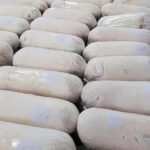According to the Vietnam Pepper Association (VPSA), by the end of February 2024, Vietnam has exported 31,133 tons of various types of pepper, bringing in a value of nearly $125 million. Compared to the same period last year, the export volume decreased by 23.7% and the value decreased by 2.9%.
The average export price of black pepper reached $3,840 per ton, while white pepper reached $5,459 per ton, increasing by 13.9% and 8.1% respectively compared to the same period in 2023.

White pepper seeds
In terms of volume, in the first 2 months of the year, Nedspice Vietnam (Netherlands) was the leading exporting company, reaching 3,555 tons, an increase of 44% compared to the same period. Olam Vietnam (India) was next with 3,229 tons, an increase of 32%.
Vietnamese companies held the next 3 positions: Tran Chau with 2,265 tons, a decrease of 33.4%; Phuc Sinh with 1,744 tons, a decrease of 31.5%; and Lien Thanh with 1,491 tons, an increase of 10.4%.

List of leading pepper exporting companies (source: VPSA)
In 2023, two foreign-invested companies, Olam Vietnam and Nedspice Vietnam, respectively ranked first and second in the ranking of the largest pepper exporting companies. Vietnamese companies ranked in the next 2 positions: Tran Chau and Phuc Sinh.
Previously, Tran Chau and Phuc Sinh held the top positions in Vietnam’s pepper exports. Mr. Phan Minh Thong, the founder of Phuc Sinh company, was often referred to as the “pepper king” because of this reason.
However, when considering the overall spice industry (pepper, cinnamon, cloves, etc.) exported to the European market, Phuc Sinh still holds the number 1 position with a 15% market share in 2023.
Pepper is one of the agricultural products that has experienced a hot price increase in recent times, with a growth rate of about 30% compared to the same period last year. The main reasons are the reduced production area of about 5,000 hectares due to crop conversion and the decreased productivity due to weather conditions.












